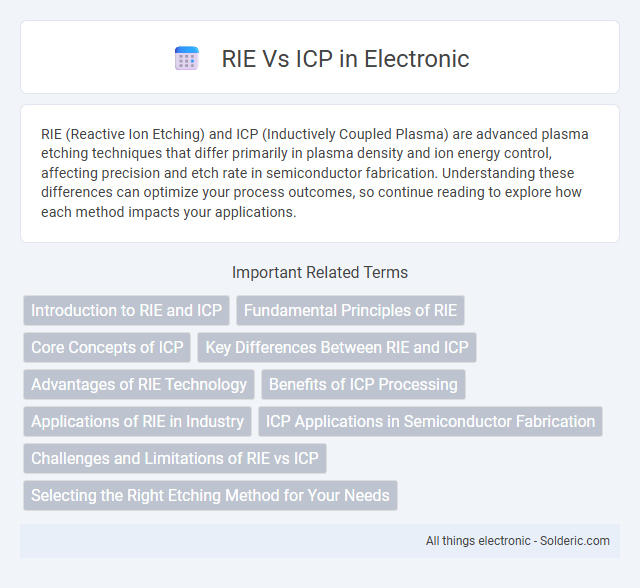RIE (Reactive Ion Etching) and ICP (Inductively Coupled Plasma) are advanced plasma etching techniques that differ primarily in plasma density and ion energy control, affecting precision and etch rate in semiconductor fabrication. Understanding these differences can optimize your process outcomes, so continue reading to explore how each method impacts your applications.
Comparison Table
| Feature | RIE (Rapid Improvement Event) | ICP (Incident Command Post) |
|---|---|---|
| Purpose | Identify and implement quick process improvements | Manage and coordinate emergency or incident response |
| Duration | Typically 3-5 days | Duration varies based on incident; can last hours to days |
| Scope | Focused on specific process or workflow | Focused on incident management and operational control |
| Key Activities | Root cause analysis, brainstorming, solution implementation | Resource allocation, communication, situational assessment |
| Team Composition | Cross-functional team from relevant departments | Incident commanders, safety officers, logistics personnel |
| Outcome | Process improvements, increased efficiency | Effective incident mitigation and control |
| Use Case | Business process optimization | Emergency management and response |
Introduction to RIE and ICP
Reactive Ion Etching (RIE) and Inductively Coupled Plasma (ICP) are advanced plasma etching techniques widely used in semiconductor fabrication for precise material removal. RIE combines chemical and physical etching mechanisms by using chemically reactive ions accelerated toward the substrate, enabling anisotropic etching with high selectivity. ICP utilizes a high-density plasma generated by an inductive coil, offering independent control of ion energy and density, which enhances etch rate uniformity and allows deeper, highly directional etching essential for your microfabrication process.
Fundamental Principles of RIE
Reactive Ion Etching (RIE) operates on the fundamental principles of combining physical sputtering and chemical reactions to achieve precise material removal. It uses ionized plasma to generate reactive species that chemically react with the substrate while directional ion bombardment enhances etch anisotropy and rate control. This dual action offers high selectivity and control over etch profiles, critical for semiconductor fabrication and microelectromechanical systems (MEMS) production.
Core Concepts of ICP
ICP, or Inductively Coupled Plasma, is a technique that generates a high-temperature plasma using an electromagnetic coil to ionize argon gas, enabling efficient excitation and ionization of sample atoms for elemental analysis. The core concept of ICP revolves around creating a stable plasma environment that produces excited atoms emitting characteristic wavelengths, which are then measured in ICP spectroscopy for highly sensitive and precise multi-element detection. You can rely on ICP's ability to provide rapid, quantitative elemental data critical for applications in environmental testing, metallurgy, and pharmaceuticals.
Key Differences Between RIE and ICP
Reactive Ion Etching (RIE) uses a combination of physical sputtering and chemical reactions to precisely etch materials, while Inductively Coupled Plasma (ICP) relies on high-density plasma generated by inductive coils for deeper and more uniform etching. RIE typically operates at lower plasma densities and pressures, providing better anisotropy and control for fine patterning, whereas ICP achieves higher etch rates and selectivity suitable for large-scale or high-aspect-ratio features. Your choice between RIE and ICP should consider the required etch profile, material type, and throughput needs for optimal semiconductor fabrication.
Advantages of RIE Technology
RIE technology offers precise control over etching depth and anisotropy, enabling highly accurate microfabrication in semiconductor manufacturing. It produces smoother sidewalls and reduces substrate damage compared to ICP, enhancing device performance and yield. RIE's cost-effectiveness and compatibility with a wide range of materials make it a preferred choice for applications requiring fine patterning and high resolution.
Benefits of ICP Processing
Inductively Coupled Plasma (ICP) processing offers superior etching uniformity and higher selectivity compared to Reactive Ion Etching (RIE), enabling precise control over etch profiles in semiconductor fabrication. ICP's high plasma density and independent control of ion energy and density reduce substrate damage while enhancing etch rates, optimizing both efficiency and device performance. This process is essential for advanced microelectronics, MEMS, and nanofabrication applications requiring fine feature definition and minimal surface roughness.
Applications of RIE in Industry
RIE (Reactive Ion Etching) is extensively used in the semiconductor industry for precise pattern transfer, enabling the fabrication of microelectronic devices with high aspect ratios and minimal damage to substrates. It is crucial in MEMS (Microelectromechanical Systems) manufacturing and photonics for creating fine features with controlled anisotropy. Your advanced microfabrication processes benefit from RIE's capability to etch complex materials like silicon dioxide and silicon nitride with exceptional accuracy.
ICP Applications in Semiconductor Fabrication
Inductively Coupled Plasma (ICP) is widely used in semiconductor fabrication for applications requiring high-density plasma and precise etching control, such as deep trench etching and advanced patterning of silicon wafers. ICP systems enable anisotropic etching with excellent selectivity and minimal substrate damage, which is crucial for fabricating microelectromechanical systems (MEMS) and nanoscale devices. Its high ion density and low ion energy minimize aspect ratio-dependent etching effects, making ICP ideal for complex semiconductor device manufacturing.
Challenges and Limitations of RIE vs ICP
RIE (Reactive Ion Etching) faces challenges such as limited selectivity and potential surface damage due to energetic ion bombardment, which can degrade sensitive materials. ICP (Inductively Coupled Plasma) offers higher ion densities and better control over plasma parameters but struggles with non-uniform etching and higher equipment complexity. Both techniques encounter limitations in etch rate control and anisotropy, impacting precision in microfabrication processes.
Selecting the Right Etching Method for Your Needs
Reactive Ion Etching (RIE) offers precise anisotropic etching ideal for creating detailed microstructures with high aspect ratios, making it suitable for semiconductor manufacturing and MEMS fabrication. Inductively Coupled Plasma (ICP) provides higher plasma density and improved etch rates, enhancing efficiency for deep etching and large-area processing. Choosing between RIE and ICP depends on required etch profile, selectivity, throughput, and material compatibility to optimize performance and cost-effectiveness in microfabrication applications.
RIE vs ICP Infographic

 solderic.com
solderic.com